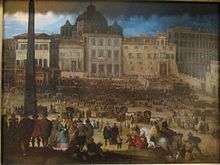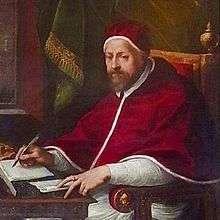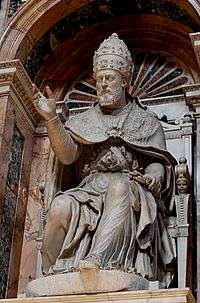Pope Clement VIII
Pope Clement VIII (Latin: Clemens VIII; 24 February 1536 – 5 March 1605), born Ippolito Aldobrandini, was head of the Catholic Church and ruler of the Papal States from 2 February 1592 to his death in 1605. Born in Fano, Italy[1] to a prominent Florentine family, he initially came to prominence as a canon lawyer before being made a Cardinal-Priest in 1585. In 1592 he was elected Pope and took the name of Clement. During his papacy he effected the reconciliation of Henry IV of France to the Catholic faith and was instrumental in setting up an alliance of Christian nations to oppose the Ottoman Empire in the so-called Long War. He also successfully adjudicated in a bitter dispute between the Dominicans and the Jesuits on the issue of efficacious grace and free will. In 1600 he presided over a jubilee which saw many pilgrimages to Rome. He had little pity for his opponents, presiding over the trial and execution of Giordano Bruno and implementing strict measures against Jewish residents of the Papal States. He may have been the first pope to drink coffee. Clement VIII died at the age of 69 in 1605 and his remains now rest in the Santa Maria Maggiore.
Pope Clement VIII | |
|---|---|
| Bishop of Rome | |
 | |
| Elected | 30 January 1592 |
| Papacy began | 2 February 1592 |
| Papacy ended | 3 March 1605 |
| Predecessor | Innocent IX |
| Successor | Leo XI |
| Orders | |
| Ordination | 31 December 1580 |
| Consecration | 2 February 1592 by Alfonso Gesualdo di Conza |
| Created cardinal | 18 December 1585 by Sixtus V |
| Personal details | |
| Birth name | Ippolito Aldobrandini |
| Born | 24 February 1536 Fano, Marche, Papal States |
| Died | 5 March 1605 (aged 69) Rome, Papal States |
| Previous post | Cardinal-Priest of San Pancrazio fouri le Mura (1585–92) |
| Other popes named Clement | |
| Papal styles of Pope Clement VIII | |
|---|---|
 | |
| Reference style | His Holiness |
| Spoken style | Your Holiness |
| Religious style | Holy Father |
| Posthumous style | None |
Early life
He was from a Florentine family, and followed his father as a canon lawyer, becoming an Auditor (judge) of the Roman Rota, the highest ecclesiastical court constituted by the Holy See.[2] He was only ordained as a priest at the age of 45, and rose to Pope in a further 12 years. He was an effective, if sometimes ruthless, administrator.
Cardinal

He was made Cardinal-Priest of S. Pancrazio in 1585 by Pope Sixtus V, who named him major penitentiary in January 1586 and in 1588 sent him as legate in Poland. He placed himself under the direction of the reformer Philip Neri, who for thirty years was his confessor. Aldobrandini won the gratitude of the Habsburgs by his successful diplomatic efforts in Poland to obtain the release of the imprisoned Archduke Maximilian, the defeated claimant to the Polish throne.[3]
After the death of Pope Innocent IX (1591), another stormy conclave ensued, in which a determined minority of Italian Cardinals were unwilling to be dictated to by Philip II of Spain. Known to be very intelligent, disciplined, and in tune with the inter workings of the Church,[4] Cardinal Aldobrandini's election on 30 January 1592 was received as a portent of more balanced and liberal Papal policy in European affairs. He took the non-politicised name Clement VIII. He proved to be an able Pope, with an unlimited capacity for work, a lawyer's eye for detail, and a wise statesman, the general object of whose policy was to free the Papacy from its dependence upon Spain.[3]
Ecclesiastical matters
Clementine Vulgate
In November 1592, he published the Clementine Vulgate.[5] It was issued with the Bull Cum Sacrorum (9 November 1592)[6] which asserted that every subsequent edition must be assimilated to this one, no word of the text may be changed, nor even variant readings printed in the margin.[7] This new official version of the Vulgate, known as the Clementine Vulgate[8] or Sixto-Clementine Vulgate,[8][9] became the official Bible of the Catholic Church.[10]
De Auxiliis controversy
In 1597, he established the Congregatio de Auxiliis which was to settle the theological controversy between the Dominican Order and the Jesuits concerning the respective role of efficacious grace and free will. Although the debate tended toward a condemnation of Molinism's insistence on free will to the detriment of efficacious grace, the important influence of the Jesuit Order — among other considerations — which, beside important political and theological power in Europe, had also various missions abroad (Misiones Jesuiticas in South America, missions in China, etc.), led the Pope to abstain from an official condemnation of the Jesuits. In 1611 and again in 1625 a decree prohibited any discussion of the matter, although it was often informally avoided by the publication of commentaries on Thomas Aquinas.
Jubilee of 1600
During the jubilee of 1600, three million pilgrims visited the holy places. The Synod of Brest was held 1595 in the Polish–Lithuanian Commonwealth, by which a great part of the Ruthenian clergy and people were reunited to Rome.[3]
Canonisations and beatifications
Clement VIII canonised Hyacinth (17 April 1594), Julian of Cuenca (18 October 1594), and Raymond of Peñafort (1601). He beatified 205 individuals, 200 of them being group martyrs; notable individuals he named as Blessed included Carlo Borromeo.
Consistories
The pope created 53 cardinals in six consistories during his pontificate; he named his two nephews Pietro and Cinzio Passeri as cardinals. Notable cardinals named during his reign included Camillo Borghese (his successor Pope Paul V) as well as the noted theologians Roberto Bellarmino and Cesare Baronio.
Foreign relations
Relations with France and Spain

The most remarkable event of Clement VIII's reign was the reconciliation to the Church of Henry IV of France (1589–1610), after long negotiations, carried on with great dexterity through Cardinal Arnaud d'Ossat, that resolved the complicated situation in France. Henry embraced Catholicism on 25 July 1593. After a pause to assess Henry IV's sincerity, Clement VIII braved Spanish displeasure, and in the autumn of 1595 he solemnly absolved Henry IV, thus putting an end to the thirty years' religious war in France.[3]
Henry IV's friendship was of essential importance to the Papacy two years later, when Alfonso II, Duke of Ferrara, died childless (27 October 1597), and the Pope resolved to attach the stronghold of the Este family to the states of the Church. Though Spain and the Emperor Rudolf II encouraged Alfonso II's illegitimate cousin, Cesare d'Este, to withstand the Pope, they were deterred from giving him any material aid by Henry IV's threats, and a papal army entered Ferrara almost unopposed.[3]
In 1598 Clement VIII won more credit for the papacy by bringing about a definite treaty of peace between Spain and France in the Peace of Vervins,[3] this put an end to their long contest, and he negotiated peace between France and Savoy as well.
Long War
In 1595, Clement VIII initiated an alliance of Christian European powers to take part in the war with the Ottoman Empire, fought mainly in Hungary, which would become known as the "Long War" and would continue past Clement's own lifetime. Facilitated by the Pope, a treaty of alliance was signed in Prague by Emperor Rudolf II and Sigismund Báthory of Transylvania. Aron Vodă of Moldavia and Michael the Brave of Wallachia joined the alliance later that year. Clement VIII himself lent the Emperor valuable assistance in men and money.[3]
Internal policies
Law enforcement
Clement VIII was as vigorous as Pope Sixtus V (1585–90) in crushing banditry in the papal provinces of Umbria and the Marche and in punishing the lawlessness of the Roman nobility.[3] Upon his ascension to the papal throne in 1592, he immediately had several noble troublemakers put to death. These included most famously Troio Savelli, scion of a powerful ancient Roman family, and the youthful and noble Beatrice Cenci, who had murdered her father – probably as a consequence of his repeated abuses. The latter case prompted many requests of clemency – rejected by the Pope, who passed the confiscated Cenci property to his own family.
Clement's strict ways also concerned philosophical and religious matters. In 1599 he ordered the Italian miller Menocchio – who had formed the belief that God was not eternal but had Himself once been created out of chaos – to be burned at the stake. A more famous case was the trial for heresy of Giordano Bruno, who was burned at the stake in 1600. Pope Clement VIII participated personally in the final phases of the trial, inviting the Cardinals in charge of the case to proceed with the verdict.
Anti-Jewish measures
Clement VIII tightened measures against the Jewish inhabitants of his territories. In 1592, the papal bull Cum saepe accidere forbade the Jewish community of the Comtat Venaissin of Avignon, a papal enclave, to sell new goods, putting them at an economic disadvantage. In 1593, the bull Caeca et Obdurata reiterated Pope Pius V's decree of 1569 which banned Jews from living in the Papal states outside the cities of Rome, Ancona, and Avignon. The main effect of the bull was to evict Jews who had returned to areas of the Papal States (mainly Umbria) after 1586 (following their expulsion in 1569) and to expel Jewish communities from cities like Bologna (which had been incorporated under papal dominion since 1569).[11] The bull also alleged that Jews in the Papal States had engaged in usury and exploited the hospitality of Clement VIII's predecessors "who, in order to lead them from their darkness to knowledge of the true faith, deemed it opportune to use the clemency of Christian piety towards them" (alluding to Christiana pietas).[12] With the bull Cum Hebraeorum malitia a few days later, Clement VIII also forbade the reading of the Talmud.[13]
Later life and death

Clement VIII was afflicted by gout, and was forced to spend much of his later life immobilized in bed. He suddenly became ill on 10 February 1605 and his condition rapidly deteriorated over the next few weeks. He died on 3 March 1605 around midnight, leaving a reputation for prudence, munificence, ruthlessness and capacity for business. Clement was buried in St. Peter's Basilica, and later Pope Paul V (1605–21) had a mausoleum built for him in the Borghese Chapel of Santa Maria Maggiore, where the remains were transferred in 1646.
His reign is especially distinguished by the number and beauty of his medals. Clement VIII founded the Collegio Clementino for the education of the sons of the richer classes, and augmented the number of national colleges in Rome by opening the Collegio Scozzese for the training of missionaries to Scotland.[3]
Coffee
Coffee aficionados often claim that the spread of its popularity among Catholics is due to Pope Clement VIII's influence. He was pressed by his advisers to denounce coffee. However, upon tasting coffee, Pope Clement VIII declared: "Why, this Satan's drink is so delicious that it would be a pity to let the infidels have exclusive use of it."[14] Clement allegedly blessed the bean because it appeared better for the people than alcoholic beverages.[15] The year often cited is 1600. It is not clear whether this is a true story, but it may have been found amusing at the time.[16]
See also
- Giovanni Aldobrandini, his older brother, who was a cardinal
- Sixto-Clementine Vulgate
- Cardinals created by Clement VIII
References
- "Clement VIII". w2.vatican.va.
- See John Paul II, ap. con. Pastor Bonus art. 121, 80 Acta Apostolicae Sedis 841 (1988) (noting that the Apostolic Signatura is the supreme tribunal).
-

- “Pope Clement VIII,” Italian Baroque Art, Duke University
- Metzger, Bruce M. (1977). The Early Versions of the New Testament. Oxford: Clarendon Press. p. 349.
- "Vulgata Clementina". vulsearch.sourceforge.net. Retrieved 2019-09-17.
- Scrivener, Frederick Henry Ambrose; Edward Miller (1894). A Plain Introduction to the Criticism of the New Testament. 2 (4 ed.). London: George Bell & Sons. p. 65.
- Pelikan, Jaroslav Jan (1996). "1 : Sacred Philology ; Catalog of Exhibition [Item 1.14]". The reformation of the Bible, the Bible of the Reformation. Dallas : Bridwell Library ; Internet Archive. New Haven: Yale University Press. pp. 14, 98.
- Gerace, Antonio (2016). "Francis Lucas 'of Bruges' and Textual Criticism of the Vulgate before and after the Sixto-Clementine (1592)". Journal of Early Modern Christianity. 3 (2): 201–237. doi:10.1515/jemc-2016-0008 – via KULeuven.
- Houghton, H. A. G. (2016). The Latin New Testament: A Guide to Its Early History, Texts, and Manuscripts. Oxford University Press. pp. 132–133. ISBN 9780198744733.
- Foa, Anna; Grover, Andrea (2000). The Jews of Europe After the Black Death. University of California Press. p. 117. ISBN 978-0520087651.
- Fragnito, Gigliola; Mozzarelli, Cesare; Oresko, Robert (2001-09-06). Church, Censorship and Culture in Early Modern Italy. p. 182–183. ISBN 9780521661720.
- S. Wendehorst, "Katholische Kirche und Juden in der Frühen Neuzeit" 1.3 "Zensur des Talmud", following Willchad Paul Eckert, "Catholizmus zwischen 1580 und 1848" in Karl Heinrich Rengstorf and Siegfried Kortzfleisch, eds. Kirche und Sinagoge II (Stuttgart, 1970) p. 232.
- Cole, Adam. "Drink Coffee? Off With Your Head!", Salt, NPR, January 17, 2012
- Wallin, Nils-Bertil. "Coffee: A Long Way From Ethiopia", Yale Global, November 5, 2002 Archived April 1, 2016, at the Wayback Machine
- "Archived copy". Archived from the original on 2010-06-01. Retrieved 2010-06-08.CS1 maint: archived copy as title (link) Coffee Facts and Statistics
External links
| Wikimedia Commons has media related to Clemens VIII. |
| Catholic Church titles | ||
|---|---|---|
| Preceded by Innocent IX |
Pope 30 January 1592 – 3 March 1605 |
Succeeded by Leo XI |